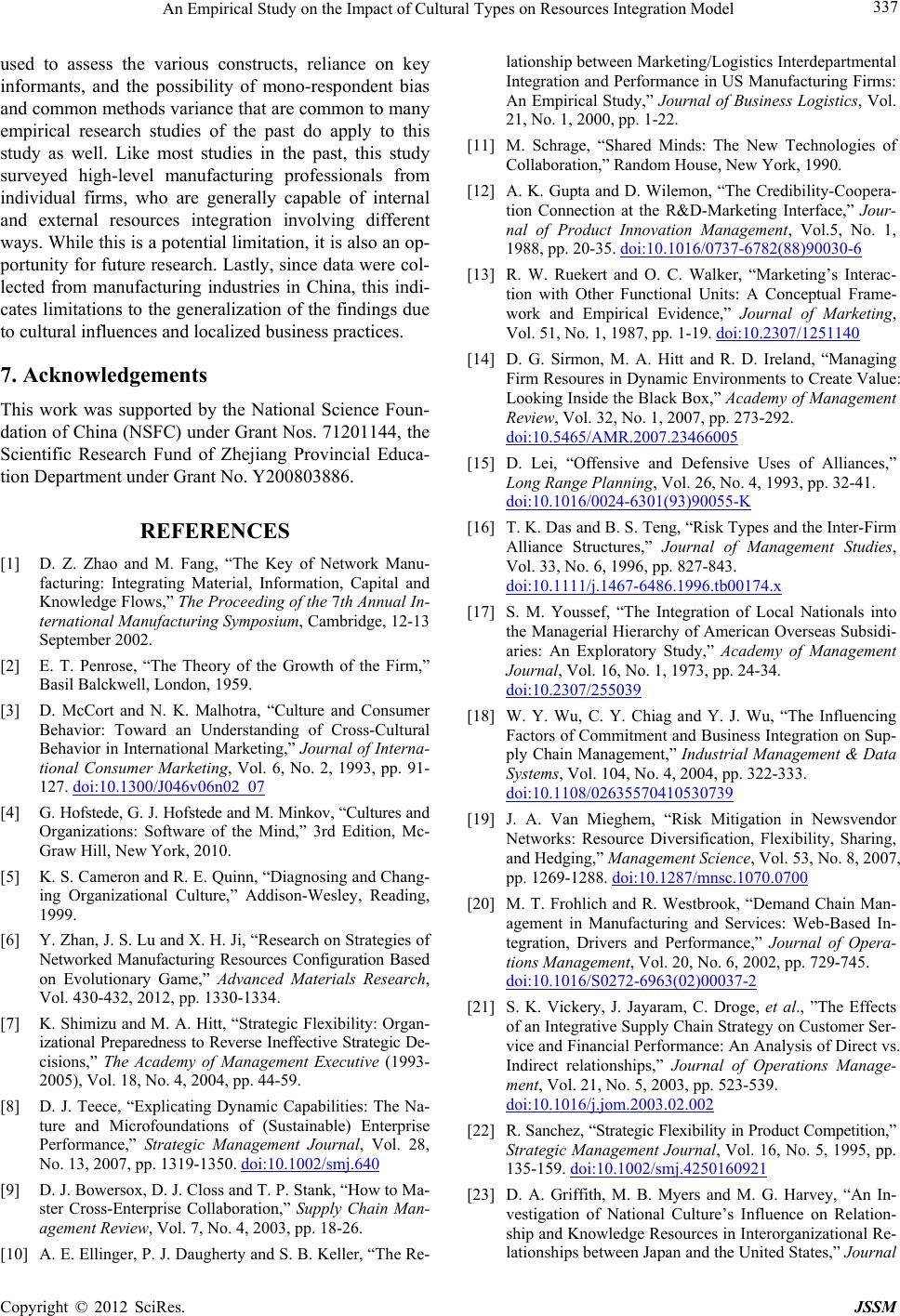
An Empirical Study on the Impact of Cultural Types on Resources Integration Model 337
used to assess the various constructs, reliance on key
informants, and the possibility of mono-respondent bias
and common methods variance that are common to many
empirical research studies of the past do apply to this
study as well. Like most studies in the past, this study
surveyed high-level manufacturing professionals from
individual firms, who are generally capable of internal
and external resources integration involving different
ways. While this is a potential limitation, it is also an op-
portunity for future research. Lastly, since data were col-
lected from manufacturing industries in China, this indi-
cates limitations to the generalization of the findings due
to cultural influences and localized business practices.
7. Acknowledgements
This work was supported by the National Science Foun-
dation of China (NSFC) under Grant Nos. 71201144, the
Scientific Research Fund of Zhejiang Provincial Educa-
tion Department under Grant No. Y200803886.
REFERENCES
[1] D. Z. Zhao and M. Fang, “The Key of Network Manu-
facturing: Integrating Material, Information, Capital and
Knowledge Flows,” The Proceeding of the 7th Annual In-
ternational Manufacturing Symposium, Cambridge, 12-13
September 2002.
[2] E. T. Penrose, “The Theory of the Growth of the Firm,”
Basil Balckwell, London, 1959.
[3] D. McCort and N. K. Malhotra, “Culture and Consumer
Behavior: Toward an Understanding of Cross-Cultural
Behavior in International Marketing,” Journal of Interna-
tional Consumer Marketing, Vol. 6, No. 2, 1993, pp. 91-
127. doi:10.1300/J046v06n02_07
[4] G. Hofstede, G. J. Hofstede and M. Minkov, “Cultures and
Organizations: Software of the Mind,” 3rd Edition, Mc-
Graw Hill, New York, 2010.
[5] K. S. Cameron and R. E. Quinn, “Diagnosing and Chang-
ing Organizational Culture,” Addison-Wesley, Reading,
1999.
[6] Y. Zhan, J. S. Lu and X. H. Ji, “Research on Strategies of
Networked Manufacturing Resources Configuration Based
on Evolutionary Game,” Advanced Materials Research,
Vol. 430-432, 2012, pp. 1330-1334.
[7] K. Shimizu and M. A. Hitt, “Strategic Flexibility: Organ-
izational Preparedness to Reverse Ineffective Strategic De-
cisions,” The Academy of Management Executive (1993-
2005), Vol. 18, No. 4, 2004, pp. 44-59.
[8] D. J. Teece, “Explicating Dynamic Capabilities: The Na-
ture and Microfoundations of (Sustainable) Enterprise
Performance,” Strategic Management Journal, Vol. 28,
No. 13, 2007, pp. 1319-1350. doi:10.1002/smj.640
[9] D. J. Bowersox, D. J. Closs and T. P. Stank, “How to Ma-
ster Cross-Enterprise Collaboration,” Supply Chain Man-
agement Review, Vol. 7, No. 4, 2003, pp. 18-26.
[10] A. E. Ellinger, P. J. Daugherty and S. B. Keller, “The Re-
lationship between Marketing/Logistics Interdepartmental
Integration and Performance in US Manufacturing Firms:
An Empirical Study,” Journal of Business Logistics, Vol.
21, No. 1, 2000, pp. 1-22.
[11] M. Schrage, “Shared Minds: The New Technologies of
Collaboration,” Random House, New York, 1990.
[12] A. K. Gupta and D. Wilemon, “The Credibility-Coopera-
tion Connection at the R&D-Marketing Interface,” Jour-
nal of Product Innovation Management, Vol.5, No. 1,
1988, pp. 20-35. doi:10.1016/0737-6782(88)90030-6
[13] R. W. Ruekert and O. C. Walker, “Marketing’s Interac-
tion with Other Functional Units: A Conceptual Frame-
work and Empirical Evidence,” Journal of Marketing,
Vol. 51, No. 1, 1987, pp. 1-19. doi:10.2307/1251140
[14] D. G. Sirmon, M. A. Hitt and R. D. Ireland, “Managing
Firm Resoures in Dynamic Environments to Create Value:
Looking Inside the Black Box,” Academy of Management
Review, Vol. 32, No. 1, 2007, pp. 273-292.
doi:10.5465/AMR.2007.23466005
[15] D. Lei, “Offensive and Defensive Uses of Alliances,”
Long Range Planning, Vol. 26, No. 4, 1993, pp. 32-41.
doi:10.1016/0024-6301(93)90055-K
[16] T. K. Das and B. S. Teng, “Risk Types and the Inter-Firm
Alliance Structures,” Journal of Management Studies,
Vol. 33, No. 6, 1996, pp. 827-843.
doi:10.1111/j.1467-6486.1996.tb00174.x
[17] S. M. Youssef, “The Integration of Local Nationals into
the Managerial Hierarchy of American Overseas Subsidi-
aries: An Exploratory Study,” Academy of Management
Journal, Vol. 16, No. 1, 1973, pp. 24-34.
doi:10.2307/255039
[18] W. Y. Wu, C. Y. Chiag and Y. J. Wu, “The Influencing
Factors of Commitment and Business Integration on Sup-
ply Chain Management,” Industrial Management & Data
Systems, Vol. 104, No. 4, 2004, pp. 322-333.
doi:10.1108/02635570410530739
[19] J. A. Van Mieghem, “Risk Mitigation in Newsvendor
Networks: Resource Diversification, Flexibility, Sharing,
and Hedging,” Management Science, Vol. 53, No. 8, 2007,
pp. 1269-1288. doi:10.1287/mnsc.1070.0700
[20] M. T. Frohlich and R. Westbrook, “Demand Chain Man-
agement in Manufacturing and Services: Web-Based In-
tegration, Drivers and Performance,” Journal of Opera-
tions Management, Vol. 20, No. 6, 2002, pp. 729-745.
doi:10.1016/S0272-6963(02)00037-2
[21] S. K. Vickery, J. Jayaram, C. Droge, et al., ”The Effects
of an Integrative Supply Chain Strategy on Customer Ser-
vice and Financial Performance: An Analysis of Direct vs.
Indirect relationships,” Journal of Operations Manage-
ment, Vol. 21, No. 5, 2003, pp. 523-539.
doi:10.1016/j.jom.2003.02.002
[22] R. Sanchez, “Strategic Flexibility in Product Competition,”
Strategic Management Journal, Vol. 16, No. 5, 1995, pp.
135-159. doi:10.1002/smj.4250160921
[23] D. A. Griffith, M. B. Myers and M. G. Harvey, “An In-
vestigation of National Culture’s Influence on Relation-
ship and Knowledge Resources in Interorganizational Re-
lationships between Japan and the United States,” Journal
Copyright © 2012 SciRes. JSSM